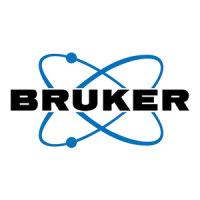ELCB
H172203_1_001 59 / 234
8.4.4 Handling of High Gradient Rates for Auto Shim and Drift Compensation
Auto Shim and Drift Compensation handles gradient pulses at high rates similar to the LCB -
if necessary, the lock level is sampled at the optimum time.
The Auto Shim has been improved so that it is no longer necessary to adapt the Auto Shim
interval to the pulse program (timing of the gradient pulses). The ELCB now guarantees
automatically the specified time interval between setting of a new shim and the measurement
of the resulting lock level, regardless of the pulse program.
Automatic drift compensation is held by the Lock Hold pulse as well. However, drift
compensation is evaluated every second and it is not affected by gradient pulses shorter than
1 second.
8.4.5 Measurements Provided for Diagnostic
When the ELCB is started up, the following tests are performed:
H0 Current Measurement
For detection of correct H0 coil connection, it is possible to measure the current that actually
flows through the shunt resistor. If the H0 coil is not properly connected, an error message is
issued by the TopSpin application.
RF Board Tests (L-TRX)
The new L-TRX provides a larger set of test functions, which are run automatically after
power up and can be invoked manually by the Service Web for diagnostics (see also
Diagnostic Functions [}110] in the section Service Web).
History of Lock Regulator and Drift Compensator
There is a history of the Lock Regulator and the Drift Compensator available on the ELCB (5
minutes with 1 entry per second, 5 hours with one entry per minute and 1 week with one
entry per hour). The data is volatile and can be accessed by the Service Web.
Display/Download of the Latest FFA
While locking in initiated by Auto Lock, the Lock performs a simple
2
H experiment
(alternatively
19
F). The resulting FID can be visualized (graph of the spectrum) and / or
downloaded (as text) by the Service Web.

